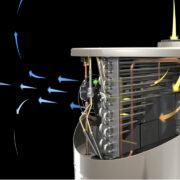I don’t know how many of you remember the old school round thermostats that you had to adjust on your own. My grandparents had one of those for … basically forever. I never understood why they didn’t replace it with a programmable one. As big of an upgrade as a programmable thermostat is over those old school thermostats, a smart thermostat is another step beyond that.
Whether you’re concerned about sustainability, saving some money, or both, getting a handle on heating and cooling your home is the best place to start since it accounts for half of our energy use.1 The simple act of turning down your temperature by 7–10 degrees for 8 hours a day can save you 10% on energy costs over the course of a year.2 Sadly, most people don’t set their thermostats properly, or just leave them at a set temperature all the time.3
And that’s where smart thermostats come in. They can help take care of the temperature adjustments for you automatically, and do it on the fly based on what’s happening in your house. The two big names in smart thermostats are Nest and Ecobee. Something like Nest uses machine learning to find patterns in how you like your home heated and cooled over time. It’s kind of like a virtual butler that will start to adjust to your patterns and anticipate what you need and when. And it can also understand when you’re not home and dial things back automatically.
But one of Ecobee’s features that give it an edge are the included remote sensors. My house has a problem that I’m sure you all experience too: the temperature can vary wildly depending on what room you’re in. My basement runs cooler than the rest of the house. Our living room gets incredibly warm in the middle of the day from the sun. And my office just tends to run cool most of the time. Having remote temperature sensors in different locations from the main thermostat allows the ecobee to take an average reading from the entire house. But the sensors also include motion sensors, so Ecobee can know which rooms are occupied and which ones aren’t. If a room is unoccupied for a certain period of time it will ignore and remove that room from the average temperature reading for the house. This, in theory, means that it will be adjusting your home to make sure that the occupied rooms are more comfortable, even if that means the unoccupied rooms get a bit too warm or too cold. The motion sensors also allow Ecobee to know if the house is empty or not, and if it is, it can automatically flip into an away mode and dial back the temperatures to save energy and money.
Not too long ago Nest released remote temperature sensors for their system, but it’s a very limited implementation compared to Ecobee. They aren’t included with the thermostat from the start. They only provide temperature information and don’t include motion detection. And you have to manually target which room’s temperature reading you want to use for controlling the entire system at different times of the day. It doesn’t average anything out or take care of itself.
When setting up the Ecobee, however, you can take a hands-off approach, set your comfort temperature settings and let the system take care of the rest. Setting up the comfort settings is very easy. By default the system has three comfort settings: Home, Away, and Sleep. All you’re doing is selecting your desired temperature and fan settings for each one. You can add more comfort settings if you want, but I’ve found the default three are plenty. One important note is that you can also assign specific temperature sensors to each comfort setting. A good example would be to select just the bedroom sensors for the Sleep setting. That ensures that only the bedroom sensors will be used to calculate the house’s average temperature at night when you’re in bed.
The next step is adjusting the default schedule, which is really just assigning one of those comfort settings for different time periods throughout the day and week. By default it will have Home and Sleep time blocks configured for the most common time frames throughout the week, but you can easily add more time blocks or adjust the ones that are there. Since the system can automatically understand if the house is empty or not, you can let it decide on its own when to flip into the Away comfort setting. All you need to do is set Home and Sleep. Otherwise, you can add Away or other custom comfort settings to the schedule to take more manual control.
You can step up things a notch by enabling geofencing in the mobile app on your phone. Depending if you leave or enter the geofenced area around your house, the system will automatically put the house into Away or Home mode. This method is faster at switching your system into Away mode since it’s not relying solely on the motion sensors in your home. It can take up to two hours of no motion before the system flips into Away mode, where using geofencing on your phone will be instant.
The final feature set that’s worth noting before I get to the pros and cons, is Home IQ. This will show you detailed reports for your equipment runtime. See exactly how often the fan was running, or when the system was actively heating and cooling. You’ll also see what the calculated average temperature was throughout the day, as well as what the outside temperature was. This helps to show how the outside temperature is affecting your system’s performance. You can also see when the system was detecting motion throughout the day. You might be able to spot patterns for what rooms are occupied throughout the day and week, and you can use that to create more customized comfort settings and schedules. And if you’re a data nerd, you can download all of this data as a CSV file, so slice and dice it anyway you like.
The system also provides some context around all of this data by showing how your home compares to other Ecobee users in your area, as well as how much energy and money it’s saved you. The community comparison can be extremely helpful to get a sense for how your temperature settings differ from everyone else, which also highlights how changing your settings may improve your results. The system also shows you how well your home retains its thermal energy compared to others in your area. This extra context can help you know if you need to look into improving the weather sealing of your home.
So how has the Ecobee worked out over the past 4 years? Well, here are the pros.
Pros
The system has been rock solid. Over the four years I’ve never experienced an outage of the Ecobee internet connectivity, and even if I did, the system can continue operating without it just fine.
The sensors throughout my house and the averaging of the temperature has absolutely helped in making our house more comfortable. It doesn’t solve the temperature variations, but it helps to dial in the temperature for the rooms that are occupied. It doesn’t matter if the basement runs a little cold if there’s nobody down there.
But for me the biggest benefit of the Ecobee system is Home IQ. I’ve used the data and reports to better understand how the choices I’m making are impacting the system’s performance. It’s tapping right into the gamer in me. I want to try and get a higher score than my neighbors, and be in the top tier of homes for my area. And because they provide all of the data and context around it, it makes it easier to understand what you have to do to try and improve your settings. I dropped the temperature settings by a couple of degrees over the winter and saw our ranking jump up.
Cons
But what about the cons? Ecobee also claims that the coin cell batteries in remote sensors will last up to 4 years. Your mileage is really going to vary there, but I’ve found the batteries to last about 2 years before needing to be replaced. Not horrible … but a far stretch from the 4 years they claim.
One of the bigger selling points for the system is the averaging of the temperature readings from the included sensors. While it definitely works, it’s not without its quirks. First is the delay built into the system with the motion detection. It errs on the side of caution because it doesn’t want to discount a room that people may be in … but are just very still. This can be frustrating because you might be spending more of your evening in the living room, but you walk through the kitchen to go to the bathroom. Even though you’re in the kitchen for only a minute, it now registers the room as occupied for quite some time before flipping back to unoccupied.
When the house is in sleep mode, it ignores the lack of motion to avoid putting the house into away mode. And as I mentioned before, it takes up to two hours of house inactivity before it flips into away mode automatically. So as nice of a feature as motion detection is on the thermostats, it’s not something you can rely on completely due to those built in delays. The result is that the household average temperature might include unoccupied rooms, which negates some of the benefits of the system.
Now while that may sound bad, it’s solvable with some adjustments to the system. Some of those cons I brought up can be minimized if you customize which sensors are in use for specific comfort settings, you can avoid the unoccupied rooms from getting included in the average temperature. For instance, you could create an Evening comfort setting and add a schedule for it between 7pm and bedtime. If you exclude the kitchen from that setting, then when you take that bathroom break from watching Tiger King in the living room, you don’t have to worry about the kitchen looking occupied to the system as you pass through it.
I’d also recommend activating geofencing. This will put the house into away mode as soon as you actually leave … instead of 2 hours later. The one downside is that it only works for one person’s phone. You can get around this limitation by using IFTTT and the Life360 apps on multiple phones. And if you’re an all iPhone household, you can use Apple Homekit to solve it. I’ll include some links in the description of how to set those up. In my case, I’m using Hubitat as the central system for my smart home, which tracks all of our different phones and flips the house, and Ecobee, into Home or Away modes.
Do I recommend the Ecobee? Absolutely. Do I recommend smart thermostats in general? 100% yes. None of us live according to a set programmed schedule, so systems like this can adjust on the fly. And when it comes to Ecobee, it also shows you through Home IQ how you can make improvements to help your situation. It’s those micro adjustments and educational screens that can help you make behavioral adjustments that add up to significant savings over time. My Ecobee may not be my AI best friend, but it’s definitely made my home more comfortable and efficient over time.
1: http://www.eia.gov/energyexplained/use-of-energy/homes.php
2: http://www.energy.gov/energysaver/thermostats
3: http://www.sciencedirect.com/science/article/abs/pii/S2214629615000730


















Comments